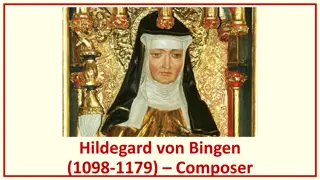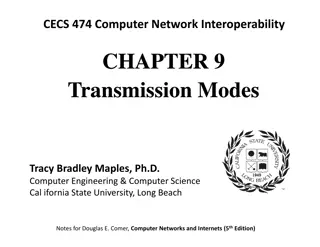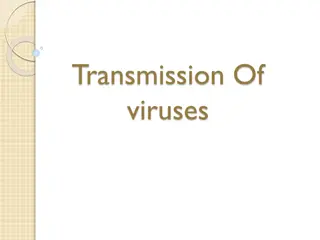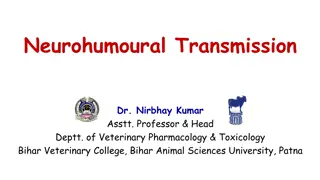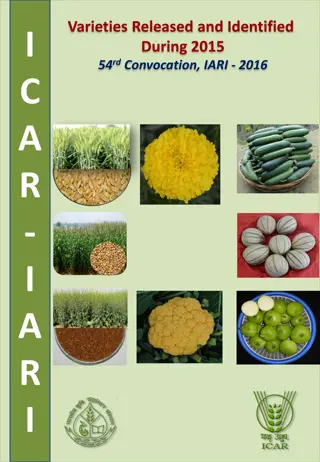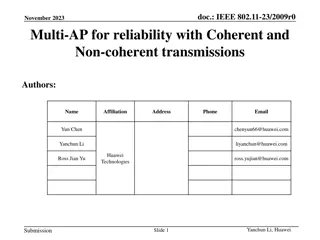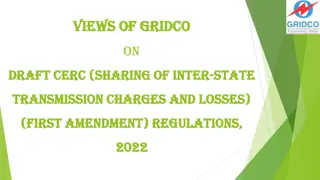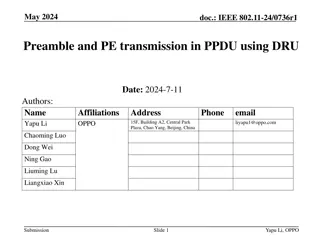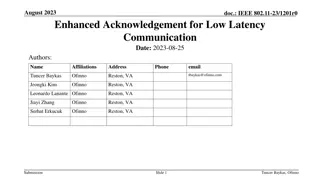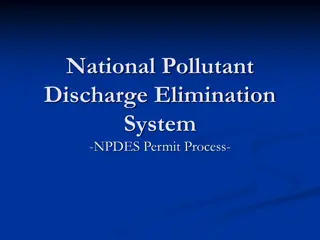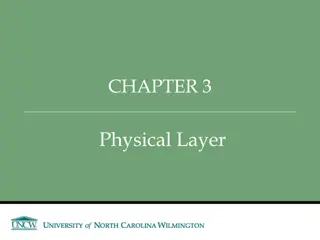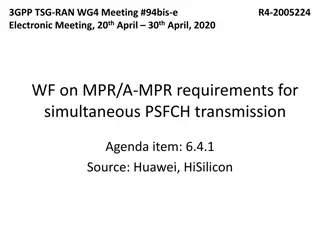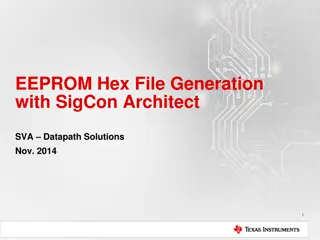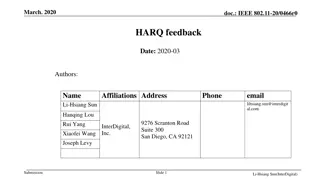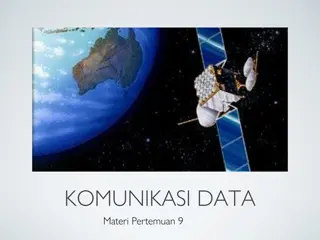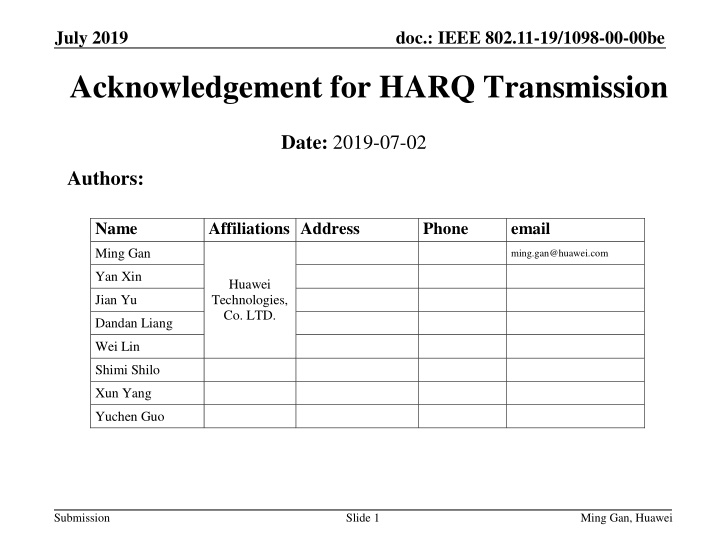
Analysis of HARQ Acknowledgement Schemes in IEEE 802.11-19/1098-00-00be Document
Explore the comparison between MPDU-based acknowledgement (MA) and Codeword-based acknowledgement (CA) in HARQ transmission, focusing on memory requirement, error detection, and retransmission size. Discover the implications and considerations associated with each scheme to enhance link adaptation efficiency.
Download Presentation

Please find below an Image/Link to download the presentation.
The content on the website is provided AS IS for your information and personal use only. It may not be sold, licensed, or shared on other websites without obtaining consent from the author. If you encounter any issues during the download, it is possible that the publisher has removed the file from their server.
You are allowed to download the files provided on this website for personal or commercial use, subject to the condition that they are used lawfully. All files are the property of their respective owners.
The content on the website is provided AS IS for your information and personal use only. It may not be sold, licensed, or shared on other websites without obtaining consent from the author.
E N D
Presentation Transcript
July 2019 doc.: IEEE 802.11-19/1098-00-00be Acknowledgement for HARQ Transmission Date: 2019-07-02 Authors: Name Affiliations Address Phone email Ming Gan ming.gan@huawei.com Yan Xin Huawei Technologies, Co. LTD. Jian Yu Dandan Liang Wei Lin Shimi Shilo Xun Yang Yuchen Guo Submission Slide 1 Ming Gan, Huawei
July 2019 doc.: IEEE 802.11-19/1098-00-00be Background Dozens of contributions [1-4] have demonstrated the gain for HARQ. HARQ is regarded as one promising solution to make link adaptation more robust and efficient by providing an extended set of MCSs with finer granularity besides throughput gain and range extension In this contribution, we make an analysis for the possible acknowledgement schemes for HARQ transmission Submission Slide 2 Ming Gan, Huawei
July 2019 doc.: IEEE 802.11-19/1098-00-00be Acknowledgement for HARQ There may exists two possible acknowledgments for HARQ transmission MPDU based acknowledgement (MA) as today Codeword based acknowledgement (CA) [5] One of the main motivations to have CA for HARQ is to reduce memory required at the receiver side However, some fatal flaw related to CA can also be observed For example, without SN for tracking each codeword In the following slides, a comprehensive comparison between CA and MA is provided Submission Slide 3 Ming Gan, Huawei
July 2019 doc.: IEEE 802.11-19/1098-00-00be Acknowledgement for HARQ Memory required at the receiver CA can avoid to store LLR of the correct codewords within the failed MPDU such that to require small memory Assume it can guarantee undetected error probability of very low value may need extra CRC On the other hand, it is also unnecessary to keep the LLR of correct codewords in the failed MPDU for MA with the same assumption on error detection of a codeword Instead, keep the correct decoded info bits From another angle, CA requires additional memory to create new scoreboard to maintain the reception status of codewords compared with MA In a word, CA does not show advantage on the required memory compared with MA, but instead has some defect. Submission Slide 4 Ming Gan, Huawei
July 2019 doc.: IEEE 802.11-19/1098-00-00be Acknowledgement for HARQ Retransmission size at transmitter Actually, retransmission size depends on comparison between the size of info bits in a codeword and the MPDU size Both two cases can be observed in the real transmission When the size of info bits in a codeword is smaller than the MPDU size, advanced MAC mechanisms can be used to reduce retransmission size for MA, i.e., fragmentation The motivation of original fragmentation is used to reduce transmission side at low SNR It is difficult to say CA or MA has obvious gain on retransmission size compared with the other Moreover, codeword retransmission would complicate transmission procedure . Submission Slide 5 Ming Gan, Huawei
July 2019 doc.: IEEE 802.11-19/1098-00-00be Acknowledgement for HARQ Besides the discussion before, additional comparison between MA and CA is provided as following CA MA Code scheme support Only LDPC Both LDPC and BCC Track tag Without SN for acknowledgement With SN for acknowledgement Check the reception status Not robust if only using parity check matrix, without CRC Robust with FCS Additional required change I. Block Ack setup, including TX/RX window, scoreboard maintaining II. Acknowledge frame, including Ack, Block Ack and so on III. Block Ack Request frame No additional change Submission Slide 6 Ming Gan, Huawei
July 2019 doc.: IEEE 802.11-19/1098-00-00be Summary Two acknowledgement schemes for HARQ transmission are compared To incorporate HARQ scheme to 802.11be without obvious complexity, recommend to reuse MPDU based acknowledgement for HARQ transmission Submission Slide 7 Ming Gan, Huawei
July 2019 doc.: IEEE 802.11-19/1098-00-00be References [1] IEEE 802.11-18/1587r1 HARQ for EHT [2] IEEE 802.11-18/1955r0 HARQ for EHT Further Information [3] IEEE 802.11-18/2029r1 HARQ in EHT [4] IEEE 802.11-18/1992r1 HARQ feasibility [5] IEEE 802.11-18/0873r0 HARQ framing Submission Slide 8 Ming Gan, Huawei
July 2019 doc.: IEEE 802.11-19/1098-00-00be SP 1 Which acknowledgement scheme do you prefer to use for HARQ transmission Option 1: MPDU based acknowledgement Option 2: Codeword based acknowledgement Submission Slide 9 Ming Gan, Huawei


